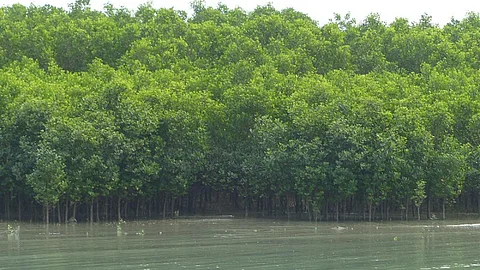
- Topics
- Feature
- Opportunities & Events
- About
- Hindi Portal
- Data
- Topics
- Feature
- Opportunities & Events
- About
- Hindi Portal
- Data

Goa’s mangrove cover increases while Sunderbans’ shrank, reports India State of the Forest Report (ISFR) 2021
Over the last year, Goa's mangrove cover increased by 1 sqkm, according to the India State of the Forest Report (ISFR) 2021 of the Forest Survey of India. Goa which lacks dense mangrove patches has moderately dense mangrove patches of 21 sqkm and open patches of 6 sqkm. The mangrove coverage in Goa has doubled since 2009, as reported in the report, attributed to plantation drives and natural regeneration.
However, the very dense mangrove cover in the Sunderbans has shrunk by two square kilometres between 2019 and 2021, from 996 sq km to 994 sq km. There was a dense mangrove cover of 999 sq km in 2017, which declined by 3 sqkm in 2019.
The progressive salinization of the delta, along with severe cyclone Amphan, which hit the delta in 2020, are among the factors behind the decline of mangrove density. (The Times of India, Hindustan Times)
National Water Awards 2020: UP bags first prize in state while Vapi, Gujarat best urban local body
In the 3rd National Water Awards-2020, announced by the Jal Shakti Ministry, Uttar Pradesh was declared the 'Best State'. It was followed by Rajasthan and Tamil Nadu. Muzaffarnagar in Uttar Pradesh, Thiruvanathapuram in Kerala, East Champaran in Bihar, Vadodara in Gujarat and Goalpara in Assam have received the first prize in the 'Best District' category. The best urban local body is Gujarat's Vapi Urban Local Body, while West Bengal's Panchgachiya MDTW WUA, Hooghly is the best water user association.
The National Water Awards recognizes and encourages the exemplary work and the efforts made by the states, individuals, districts, etc. across the country in attaining the government’s vision of ‘Jal Samridh Bharat’.
(Jagran Josh)
MP’s Gandhi Sagar Dam in need of immediate repair, warns CAG report
A recent report by the Comptroller and Auditor General of India (CAG) states that the Gandhi Sagar Dam in Madhya Pradesh needs immediate repair because of a lack of regular checks, non-functional instruments, and choked drains.
The dam built on the Chambal river in 1960 to provide water and electricity has broken several times in recent years, causing flooding in downstream areas. As much as 27 smaller dams of MP belong to Category II of the dam inspection report, while only one is in Category I. Dams with major deficiencies fall under Category I while those with minor to medium deficiencies, which are rectifiable but need immediate attention, fall under Category II. The report indicated that the dam is still under extreme threat during the rainy season despite warnings and recommendations. (Down to Earth)
Yamuna pollution: 14-fold rise in faecal coliform levels in 3 months
According to the December 2021 water quality report by the Delhi Pollution Control Committee (DPCC), the pollution in the Yamuna river has worsened with faecal bacteria levels 14 times higher than it was 3 months ago. The report further notes that at the time of exit from the city, all high-level effluents add to the contamination of the river. Faecal coliform levels during entry reached 1400 MPN/100 ml, compared to 2500 MPN/100 ml, which is the maximum permissible level. In addition, at exit, not only was it 28 times higher than the desired limits, but also 580 times higher than the maximum permissible limits.
As per the experts, poor sewage treatment and low ambient temperatures are the main reasons behind the increase in faecal levels also indicating inefficiency of STPs.
(Times Now)
Five mild earthquakes in less than a month in Chikkaballapura, officials blame heavy flooding
In just a month, Chikkaballapura was hit by five mild earthquakes ranging in magnitude from 2.7 to 3.6. As a consequence of the earthquakes' frequency, the state government requested the Karnataka State Natural Disaster Monitoring Center (KSNDMC) and the mines and geology department to investigate.
As per officials, the recent earthquakes were caused by heavy floods experienced in the drought-prone district. As a result of the floods, water entered fractured zones resulting in movement of loose rock, eventually leading to tremors or hydro-seismicity.
Local residents, however, dispute the government's claims, claiming that rampant illegal mining in the district is causing the tremors. (Hindustan Times)
This is a roundup of important news published from January 5 – 17, 2022. Also read policy matters this fortnight.